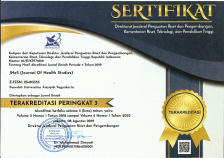Peer education effectively increases adolescents' knowledge and attitudes in preventing teenage pregnancy
DOI:
https://doi.org/10.31101/jkk.3968Abstract views 357 times
Keywords:
attitudes, knowledge, teenage pregnancyAbstract
Downloads
References
Adekola, A. P., & Mavhandu-Mudzusi, A. H. (2022). Advancing sexual and reproductive health outcomes in rural schools with the use of a sexuality education enhancement model: learners’ perspectives. Heliyon, 8(10), e11189. https://doi.org/10.1016/j.heliyon.2022.e11189
Astuti, D. P., & Sulastri, E., 2019. Universitas Muhammadiyah Purworejo Peningkatan Pengetahuan Kehamilan , Persalinan Dan Nifas Yang Sehat Melalui Kelas Ibu Hamil Increasing Knowledge Of Pregnancy , Labor And Postpartum The 9 th University Research Colloqium 2019 Universitas Muhammadiyah Pu. 7– 10
Azira, N., Binti, F., Muda, S. M., Hazariah, S., Hamid, A., Azira, N., Binti, F., Muda, S. M., Zain, N. M., Hazariah, S., & Hamid, A. (2020). The role of parents in providing sexuality education to their children. Makara Journal of Health Research, 24(3). https://doi.org/10.7454/msk.v24i3.1235
Bruce, N. G., Pope, D., & Stanistreet, D. L. (2017). Quantitative methods for health research. https://doi.org/10.1002/9781118665374
Dinkes DIY. (2022). Profile Kesehatan D.I Yogyakarta Tahun 2021. Dinas Kesehatan DIY, 76.
García-Vázquez, J., Quintó, L., & Agulló-Tomás, E. (2020). Impact of a sex education programme in terms of knowledge, attitudes and sexual behaviour among adolescents in Asturias (Spain). Global Health Promotion, 27(3), 122–130. https://doi.org/10.1177/1757975919873621
Kemen PPPA. (2023). Dispensasi Nikah pada remaja (Issue Kompensasi Nikah pada remaja).
Kemenkes RI. (2022). Profil Kesehatan Indonesia 2021. In Pusdatin.Kemenkes.Go.Id.
Kurniawan, A. T., & Rochmadhona, I. A. (2021). ISSN 2798-3641 (Online). Minat Siswa Sd Negeri Jatipuro Terhadap Olahraga Futsal, 1(6), 903. https://doi.org/10.53625/jirk.v1i6.642
Morales, M., & Gutierrez, J. (2021). Peer Education as a Tool for Sexual and Reproductive Health Education in the Philippines. Asian Pacific Journal of Health Education, 35(2), 67-78.
Nirandara, S., & et al. (2022). Dampak Pendidikan Sebaya terhadap Pencegahan Kehamilan Remaja di Thailand. Jurnal Kesehatan Masyarakat Thailand, 25 (3), 130-138.
DOI: 10.1002/jtph.2022.25.3.130
Nurfazriah, I., & Hartati, A. (2023). Efektivitas Promosi Kesehatan dengan Metode Peer Education terhadap Pengetahuan dan Sikap Remaja Putri tentang Dampak Pernikahan Dini di SMPN 5 Cilegon. DIAGNOSA: Jurnal Ilmu Kesehatan …, 1(3), 306–318. https://doi.org/10.59581/diagnosa-widyakarya.v1i3.1292
Nurmala, I., Muthmainnah, Hariastuti, I., Devi, Y. P., & Ruwandasari, N. (2021). The role of knowledge, attitude, gender, and school grades in preventing drugs use: Findings on students’ intentions to participate in peer education program. Journal of Public Health Research, 10(3). https://doi.org/10.4081/jphr.2021.1972
Putri, Cokorda, Pradnyawati, L. G., & Sumadewi, K. T. (2022). Gambaran Pengetahuan Dan Sikap Remaja Putri Terhadap Kesehatan Reproduksi Pada Siswi SMPN 1 Ubud. Aesculapius Medical Journal |, 2(3), 137–142. Https://Www.Ejournal.Warmadewa.Ac.Id/Index.Php/Amj/Article/View/5549
Phan, N., & et al. (2021). Peran Pendidikan Sebaya dalam Mencegah Kehamilan Remaja: Sebuah Studi di Vietnam. Jurnal Pendidikan Kesehatan Reproduksi, 27 (1), 34-42.
DOI: 10.1016/j.jrhe.2021.01.005 Putri, Cokorda, Pradnyawati, L. G., & Sumadewi, K. T. (2022). Gambaran Pengetahuan dan Sikap Remaja Putri terhadap Kesehatan Reproduksi pada Siswi SMPN 1 Ubud. Aesculapius Medical Journal |, 2(3), 137–142. https://doi.org/10.59581/diagnosa-widyakarya.v1i3.1292
Rashid, A., & et al. (2020). Peer Education for Adolescent Pregnancy Prevention in Bangladesh. South Asian Journal of Health Education, 10(1), 102-111.
DOI: 10.3144/sajhe.2020.10102
Ratnasari, D., & Sulistyaningsih. (2023). Preventing teenage pregnancy in developing countries : a scoping review. 39(6). https://doi.org/10.22146/bkm.v39i06.8053
Salfadila, A., Emi Sutrisminah., & Endang Susilowati. (2023). Pengaruh Pendidikan Kesehatan terhadap Pencegahan Kehamilan tidak diinginkan pada Remaja Putri di Sekolah Menengah Pertama : Literature Review. Media Publikasi Promosi Kesehatan Indonesia (MPPKI), 6(8), 1527–1537. https://doi.org/10.56338/mppki.v6i8.3550
Santisouk, P., Hansana, V., & Thanh Huong, N. (2020). Pregnancy Health Literacy Among Teenagers In Kaysone District, Savannakhet Province, Lao PDR. Global Health Action, 13(Sup2). Https://Doi.Org/10.1080/16549716.2020.1791412
Sari, Y., Lia, L., & Ramli, N. (2021). Efektifitas Peer Group Education Dan Penyuluhan Terhadap Peningkatan Pengetahuan Kesehatan Reproduksi Remaja Putri. Journal of Healthcare Technology and Medicine, 7(2), 566–580. https://doi.org/10.33143/jhtm.v7i2.1565
Sharmila, S. (2021). Awareness And Attitude Regarding Teenage Pregnancy Among Adolescent Girls Of Chandannath Municipality, Jumla. Women Health Care And Issues, 4(4), 01–06. Https://Doi.Org/10.31579/2642-9756/049
Setyaningsih, P. H., Hasanah, U., Romlah, S. N., & Risela, E. (2021). Hubungan Tingkat Pengetauan Kesehatan Reproduksi Dengan Perilaku Seksual Remaja Pada Siswa Siswi Di Smk Sasmita Jaya 1 Pamulang. Edu Dharma Journal: Jurnal Penelitian Dan Pengabdian Masyarakat, 5(1), 87. https://doi.org/10.52031/edj.v5i1.97
UNICEF. (2020). Brief on the Social Ecological Model. 1–3. https://www.unicef.org/media/135011/file/Global%20multisectoral%20operational%20framework.pdf
Siva, V., Nesan, G. S. C. Q., & Jain, T. (2021). Knowledge, attitude and perception of sex education among school going adolescents in urban area of Chennai, Tamil Nadu. Journal of Family Medicine and Primary Care, 10(1), 259–264. https://doi.org/10.4103/jfmpc.jfmpc_1650_20
World Health Organization. (2022) Tingkat kelahiran remaja (per 1000 wanita berusia 15–19 tahun). 2023. Adolescent pregnancy. https://www.who.int/news-room/fact-sheets/detail/adolescent-pregnancy. Retrieved February 5, 2023, from https://www.who.int/data/nutrition/nlis/info/adolescent-birth-rate-(per-1000-women-aged-15-19-years)
World Health Organization. (2023) Tingkat kelahiran remaja (per 1000 wanita berusia 15–19 tahun). Adolescent pregnancy. https://www.who.int/news-room/fact-sheets/detail/adolescent-pregnancy. Retrieved February 5, 2023, from https://www.who.int/data/nutrition/nlis/info/adolescent-birth-rate-(per-1000-women-aged-15-19-years)
Wondimagegene, Y. A., Debelew, G. T., & Koricha, Z. B. (2023). Effectiveness of peer-led education interventions on contraceptive use, need, and demand among adolescent girls in Gedeo Zone, South Ethiopia. A cluster randomized controlled trial. Global Health Action, 16(1). https://doi.org/10.1080/16549716.2022.2160543
Yaya, S., Zegeye, B., Ahinkorah, B. O., Oladimeji, K. E., & Shibre, G. (2020). Inequality In Fertility Rate Among Adolescents: Evidence From Timor-Leste Demographic And Health Surveys 2009–2016. Archives Of Public Health, 78(1), 1–10. Https://Doi.Org/10.1186/S13690-020-00484-1
Downloads
Published
How to Cite
Issue
Section
License
Copyright (c) 2025 Jurnal Kebidanan dan Keperawatan Aisyiyah

This work is licensed under a Creative Commons Attribution-ShareAlike 4.0 International License.
With the receipt of the article by the Jurnal Kebidanan dan Keperawatan Aisyiyah Editorial Board and the decision to be published, then the copyright regarding the article will be diverted to Jurnal Kebidanan dan Keperawatan Aisyiyah. Universitas 'Aisyiyah Yogyakarta as the publisher of Jurnal Kebidanan dan Keperawatan Aisyiyah hold the copyright regarding all the published articles in this journal.
Jurnal Kebidanan dan Keperawatan Aisyiyah is licensed under a Creative Commons Attribution-ShareAlike 4.0 International License.




















